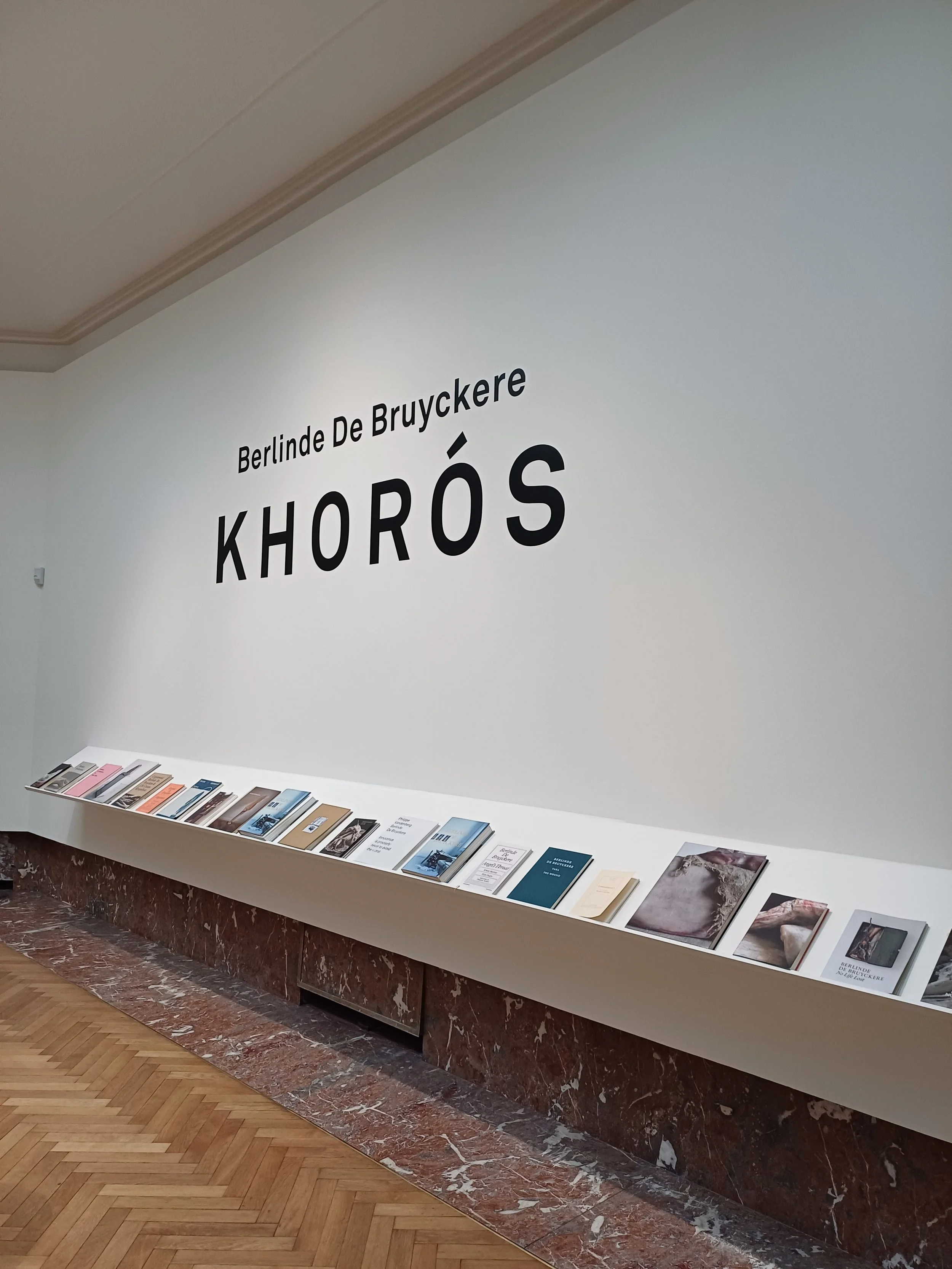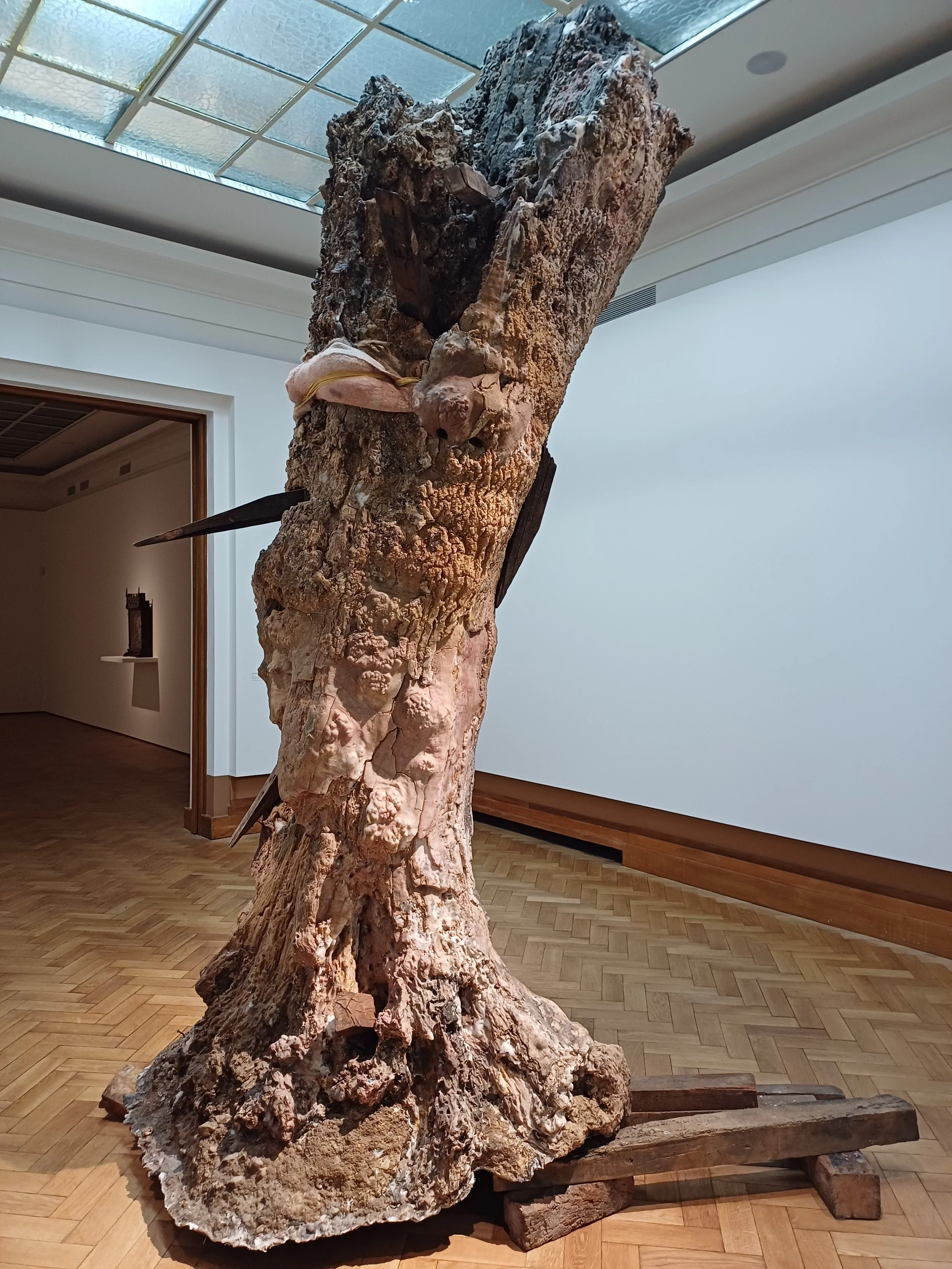Where Cruelty Is a Waste of Pain
It is summer, and once again twilight finds me climbing the ancient neck of the mountain to take my seat for the performance in Epidaurus, which for us Greeks is a kind of religious ritual. In this threshing floor of time, everything finds its rightful place. You stand between the underworld and the cosmic, in the presence of memory, of the dead, of myth. You stand in the theatre, a tiny dot of humanity encircled by the sacred geometry of a ritual. Here, we wait for the theatre to lift us toward a miracle. As I walk into Khorós, Berlinde De Bruyckere’s magisterial solo exhibition at Bozar Centre for Fine Arts in Brussels, I feel this ancient feeling returning.
The exhibition takes its name from the Greek word khorós (Xορός), the chorus of singers and dancers in Greek tragedy. De Bruyckere presents a selection of her works from the past twenty-five years, in conversation with kindred spirits—her “compagnons de route,” as she’s said—including Lucas Cranach the Elder, Peter Buggenhout, Patti Smith, and Pier Paolo Pasolini. To me, the title refers not only to a chorus of voices, but to a ceremony forged through the same dynamic between sky and earth that animates the ancient stage.
In Ancient Greek drama, the Chorus is the protagonist. It is a significant opportunity to be part of the Chorus, and some of our greatest national actresses were shaped in its shadow, born from its collective breath rather than the spotlight. The performance begins usually with the rhythm of the Chorus, which tunes the rest of the drama. These theatres are attuned to universal laws of vibration, energy, the spiral, and the conversation between earth and sky. They are built upon primary forms and cosmic alignments, and if you manage to connect with the deep architecture of these spaces, you begin to feel things that are rare and sacred.
From the moment I step into the exhibition, I feel something furiously religious. I recall Peter Berger’s quote: “The assumption we live in a secularized world is false. The world today is as furiously religious as it ever was.”[1] The sacred in De Bruyckere’s exhibition is not doctrinal. It is animal, vegetal, and erotic. A gigantic horse greets me when I step into the exhibition, hanging from one leg. The horse has appeared in her work for over two decades—a recurring figure, a defenseless martyr. “I want to show how helpless a body can be,” the Belgian artist once said. Initially developed in response to World War I images for the In Flanders Fields Museum, her equine forms carry a silent grief. At Bozar, we also witness a foal lying on a marble table in Lost V (2021–22), resting on a worn blanket, calling to mind Francisco de Zurbarán’s Agnus Dei (c. 1635–40). Immediately, I also recall Uffe Isolotto’s haunting centaur from the Danish Pavilion of the Venice Biennale 2022, where the same defenseless martyrdom is on display.
When I see her work, I often think of the butcher’s shop where her parents worked, the knowledge that she accumulated coming from flesh. In this way, her use of wax, horsehide, wood, blankets, and hair forms is sourced from an elemental vocabulary. These materials hold life within figures that are never cleanly anthropomorphic, but are always partial, wounded, vegetal, sometimes genital, sometimes floral. There is no neat boundary between human and non-human, body and landscape.
De Bruyckere’s greatest influence is, unmistakably, Pier Paolo Pasolini. For both artists, the saint is not a moral figure but a creature of mystical beauty, desire, and pain. They ask: What happens when the divine enters the secular? In her works born during the isolation of the pandemic to pay a powerful tribute to healthcare workers and caregivers, her angels are not divine messengers of hope; rather, they are faceless figures wrapped in cowhide and wax, caught in an ambiguous movement between rising and falling.
De Bruyckere also often returns to the blanket, recurring across her career as both comfort and concealment. In Courtyard Tales (2017–18), the blankets were left outside to decay, like abandoned relics of a failed social contract. They became compost for new sculptures, softened, sullied, and undone by weather and time. As with her other work, these are offerings of transformation. Nothing perishes. Everything is returned to the earth.
In some of her newer works animated by Eros, she turns to the lingam, the phallic symbol of divine generative energy in Hindu Shaivism. Her sculptures, encased in glass domes usually reserved for Christian relics, merge sexuality with sanctity. At Bozar, genitals blossom into flowers and then wither. Here, the erotic and the sacred are not opposites, but are bound together. These pieces echo Pasolini’s aching bodies, as well as the lush, sensual visual worlds of Fellini and Sorrentino, where Catholicism is soaked in gold, perfume, and flesh.[2]
After carnal martyrdom, ancient tragedy always moves toward catharsis. Its protagonists are torn apart by human passions, only in the end to be released through a fatal, divine logic. Pentheus is dismembered by the Bacchae and his mother hoists his head aloft. Hector is dragged behind Achilles’s chariot. Prometheus has his liver devoured daily. Oedipus lays with his mother. They are brutal, corporeal, and gory stories, and yet through them, we reach a kind of pedagogy through flesh.
We can feel a sense of relief in De Bruyckere’s sculptures. A soft landing. An ancient catharsis for the return to the body, to the animal, the vegetal, the cosmic first. A reconnection with the primal rhythms of being, where flesh is not weakness, where the collapse of the body and spirit can bring about a strange sense of transcendence.
“I don’t shy away from the wound; suffering, decay, death, and loneliness are as much a part of my work as they are of life. But the same goes for tenderness, connection, vitality, and lust.”[3]
— Berlinde De Bruyckere
Can carnality be read in an artwork without cruelty? To create works that speak of martyrdom without glorifying pain is an extraordinary feat. De Bruyckere never slips into sanctimony; her work does not glorify suffering. She understands, as Annie Dillard wrote, that “cruelty is a waste of pain.”[4] She handles pain with the utmost tenderness, allowing it space to exist not as spectacle, but as witnessing.
The giant fallen elm, coated in flesh-toned wax and bound like a wounded body, alludes to Saint Sebastian, the patron saint of Venice, so often depicted tied to a tree and pierced by arrows, his flesh offered to both pain and faith. Here, the martyr is absent. What remains is a giant, restful, absorbent, and liminal being.
De Bruyckere works like a carnal magician, conjuring life from flesh, wax, and wood. She gives form to the totemic, to the soul housed in matter. And through the slow, sacred work of looking, I begin to think of cruelty not only as something that was, but as something I am still responsible for preventing.
Berlinde De Bruyckere: Khorós is on view at Bozar Centre for Fine Arts from February 21 thorugh August 31, 2025.
[1] Peter L. Berger, “The Desecularization of the World: A Global Overview,” in The Desecularization of the World: Resurgent Religion and World Politics (Ethics and Public Policy Center; William B. Eerdmans Publishing Co., 2001), 1–19.
[2] Pierpaolo Antonello, “From La dolce vita to La grande bellezza: Secularization, Profanation, and Nostalgia for the Sacred,” Italica 101, no. 3 (Fall 2024): 460–476.
[3] Lotte Poté, “Between strength and vulnerability: Berlinde De Bruyckere in dialogue with old masters,” Bozar, June 12, 2025, https://www.bozar.be/en/watch-read-listen/between-strength-and-vulnerability.
[4] Annie Dillard, Pilgrim at Tinker Creek (Harper & Row, 1985).







